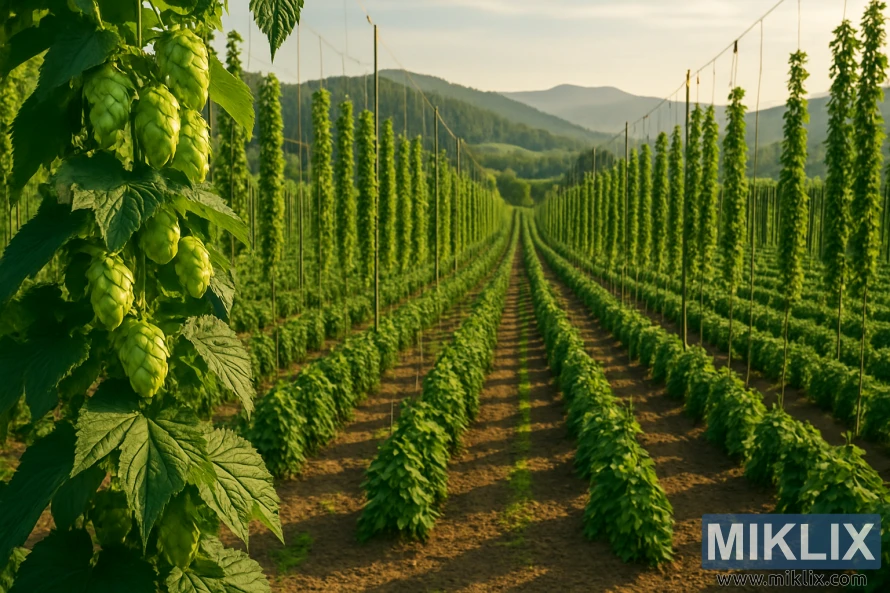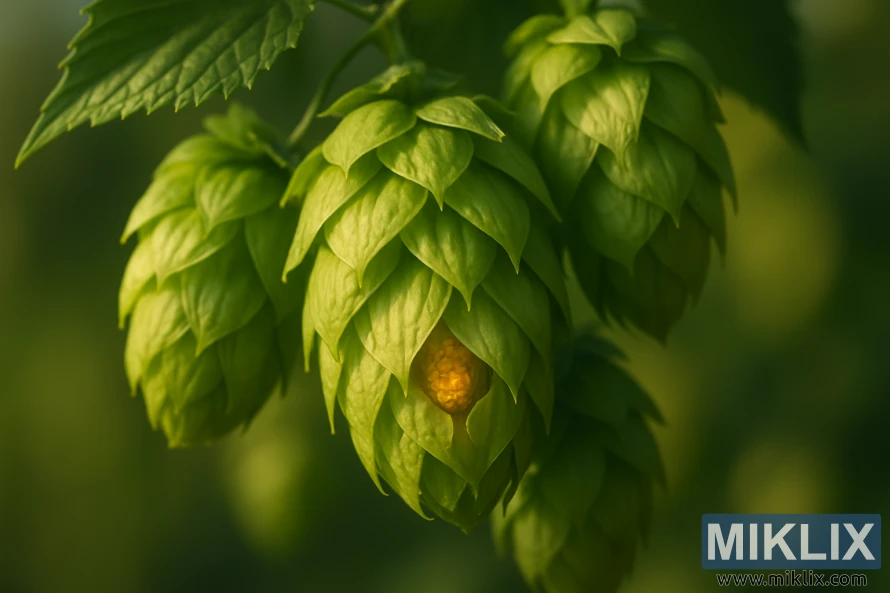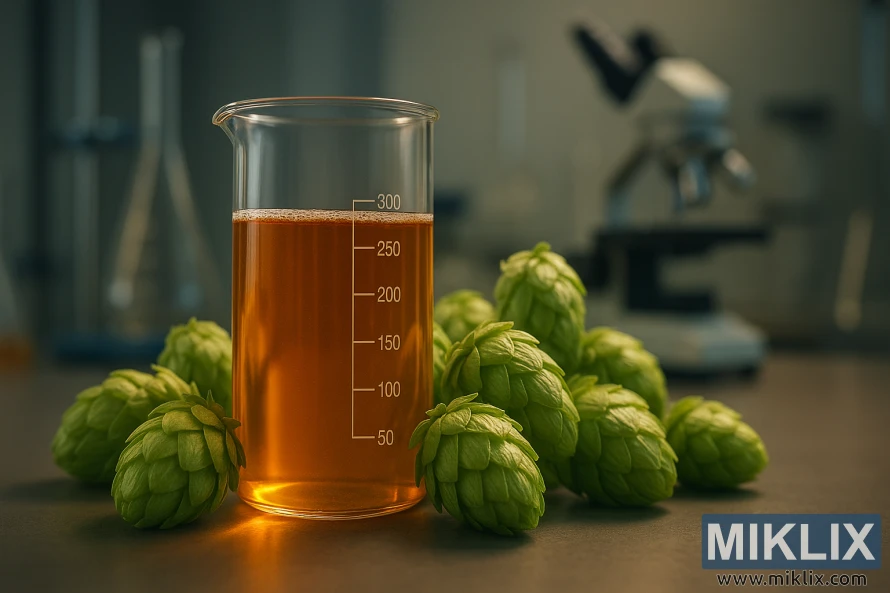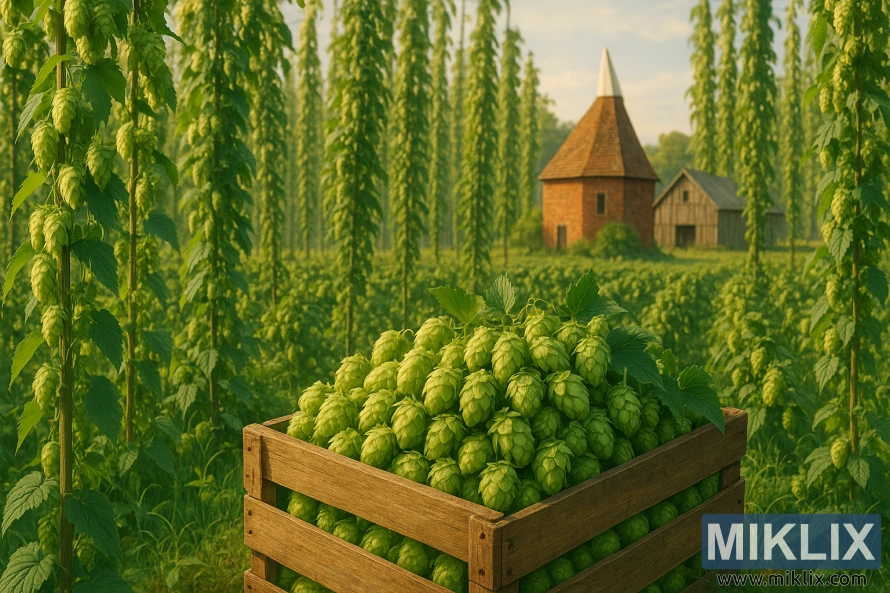Hops in Beer Brewing: Newport
Published: November 22, 2025 at 10:50:28 PM UTC
As a bittering hop, Newport is valued for its high alpha acids. It provides clean, assertive bitterness, ideal for bold beers. Brewers often choose Newport for Barley Wine, Stout, and strong ales.

Newport is a hop bred for craft brewers. Developed by Oregon State University and the USDA, it comes from Magnum crossed with a USDA male. Introduced after decades of breeding, it marked a significant milestone in the 1990s. USDA involvement continued in some sources.
This article offers practical advice on pairings and substitutes, sourcing, and storage. It's designed for both new and experienced brewers. Newport is reliable for bittering-focused beers, ensuring consistent results.
Key Takeaways
- Newport was developed through Oregon State University hops breeding with USDA collaboration.
- The Newport hop variety is mainly used as a bittering hop due to high alpha acids.
- It delivers clean, assertive bitterness suited to Barley Wine, Stout, and strong ales.
- This guide covers origin, lab values, practical usage, pairings, and storage.
- Newport supports precise bitterness without adding heavy aroma characters.
Overview of Newport hops and their role in brewing
Newport is renowned as a key bittering hop. It's used early in the boil to create a clean, firm bitterness. This approach keeps the beer balanced, without overpowering it with hop flavors.
The Pacific Northwest bred Newport to fight powdery mildew, a common issue in Oregon and Washington. Oregon State University and the USDA worked together. They crossed Magnum with a USDA male to create a hop with strong traits and consistent yields.
Newport falls into the high alpha hops category, making it efficient in delivering bitterness. This efficiency helps in reducing hop weight and cost, which is beneficial for achieving target IBU levels. Its focus on bitterness distinguishes it from aroma-focused hops, ensuring a subtle late-hop character.
Despite its bittering reputation, Newport has higher co-humulone and myrcene than Magnum. This gives it a unique aroma when used in larger amounts. Brewers prefer it for its restrained flavor and a hint of hop character in the background.
Typically, brewers use Newport for bittering early in the boil and for small whirlpool additions to balance the beer. Its high alpha content and disease resistance make it a favorite for brewers seeking a stable bitterness without overpowering hop aromas.
Newport hops
Newport, with the international NWP hop code, is marketed under its name. It comes from Oregon State University's breeding programs. These programs combined a Magnum parent with a USDA male. This mix is behind Newport's high alpha-acid content and its ability to resist diseases.
The goal of the Pacific Northwest origin of Newport was to enhance mildew resistance. This was to protect regional yields during high disease years. Growers in Washington and Oregon chose Newport for its consistent field performance and strong bittering.
Newport is a key bittering hop, alongside Magnum and Nugget. Its oil profile leans towards sharp aroma notes. These include wine, balsamic, and earthy tones, adding character when used correctly in brewing.
Availability of Newport can vary by supplier and harvest year. It is sold in whole-cone and pellet formats, with different pack sizes. Major lupulin producers like Yakima Chief, BarthHaas, and Hopsteiner do not currently offer cryo or lupomax versions of this variety.
- Official designation: NWP hop code
- Breeding: Magnum × USDA male, developed at Oregon State University
- Primary trait: mildew resistance suited to Newport origin
- Brew use: classic bittering with sharper aroma edges due to Newport genetics

Flavor and aroma profile of Newport hops
Newport hops are known for their earthy flavor with sharp, resinous notes. They offer a taste of pine, evergreen, and a dry, woody quality. This profile is reminiscent of classic bittering hops.
The aroma of Newport hops can vary based on timing and method of use. Early boil additions result in a clean, firm bitterness. Late additions or dry hopping, on the other hand, introduce spicy, balsamic, and wine-like flavors. These add complexity without making the beer muddy.
Myrcene contributes citrus and fruity notes, making some beers smell brighter than others. Humulene adds noble, woody characteristics, while caryophyllene brings a peppery, herbal edge. These elements complement malt and yeast esters well.
Minor terpenes like linalool, geraniol, and β-pinene add subtle floral and green notes. These can soften the harsher resin, creating a more layered taste experience.
When used late or as a dry hop, Newport hops can impart pungent, balsamic flavors that are reminiscent of wine. Brewers aiming for strong bitterness should use them early. For those who want to enhance aroma and depth, small late additions are best.
Practical tasting tips: use Newport hops as a stout bittering agent that can add spice and resin when used for aroma. Finding the right balance is essential. This allows the earthy hops and balsamic, wine-like flavors to enhance the beer without overpowering it.
Brewing values and lab analysis for Newport hops
Laboratory data for Newport hops is essential for brewers aiming to balance bitterness and aroma. Alpha acid content typically ranges from 10.5% to 17%, with most samples around 13.8%. Some data points span from 8.0% to 15.5%.
Beta acids usually range from 5.5% to 9.1%, averaging 7.3%. This results in an alpha-beta ratio often near 2:1. Such consistency in hop lab analysis empowers brewers to adjust IBUs with precision.
Newport hops have a notable co-humulone content, ranging from 36% to 38%, averaging 37%. This high co-humulone level contributes to a firmer, sharper bitterness compared to hops with lower co-humulone levels.
Total oils in Newport hops vary from 1.3 to 3.6 mL per 100 g, averaging 2.5 mL/100g. This oil content supports both bitterness balancing and late-addition aroma, provided it is handled with care.
- Myrcene typically makes up roughly half of the oil profile, bringing citrus and resin notes.
- Humulene appears at about 15–20%, adding woody and spicy tones.
- Caryophyllene contributes peppery, herbal facets at roughly 7–11%.
- Minor oils such as linalool and geraniol form the remaining percentage, shaping floral and fruity accents.
Hop Storage Index readings for common lots are near 0.225, or about 23% HSI. This indicates moderate stability. Expectable loss of volatile oils and alpha acids over six months at room temperature.
Consistent hop lab analysis reports enable brewers to compare batches and refine recipes. When planning, focus on Newport hop alpha acid, co-humulone, and total oils for the perfect balance in bittering and late additions.

How to use Newport hops in the boil and whirlpool
Newport boil usage excels as a primary bittering hop. Its high alpha acids facilitate efficient hop isomerization during extended boils. It's essential to plan your bittering schedule to add major additions early. This ensures the extraction of clean, stable bitterness.
Adjust IBUs for co-humulone content, which can enhance bitterness perception. Use a conservative bittering schedule for a rounded bitterness. Blending with a softer bittering hop, such as Tradition or Magnum, can soften the edge without compromising IBU targets.
Newport whirlpool additions are valuable for adding restrained spice, resin, and citrus notes. Keep whirlpool temperatures below 170°F (77°C) and limit contact time to preserve volatile oils. Short, warm rests extract flavor without forcing excessive vegetal or balsamic compounds.
A small whirlpool charge pairs well with heavy early-boil additions. Reserve most of the hop mass for the boil if you want dominant bitterness. Use the whirlpool sparingly when a subtle wine-like or balsamic lift is desired in the final beer.
- Typical role: primary bittering hop, 60–90 minute additions for main IBU.
- Whirlpool tip: add 5–20% of total hop weight at
- Adjustment: cut late additions if malt or yeast character might be overwhelmed.
Monitor hop isomerization calculations when formulating recipes. Real-world alpha ranges have varied historically, so test and taste across batches. Thoughtful bittering schedule choices let Newport deliver clean bitterness while a measured Newport whirlpool touch preserves its varietal charm.
Dry hopping and aroma considerations with Newport
Newport dry hopping brings out resinous, piney, and balsamic notes due to its oil profile. Brewers can expect a strong Newport aroma, rich in myrcene, with humulene and caryophyllene supporting it. This profile is ideal for robust styles, where darker malt or oak can add wine-like complexity.
When using Newport, it's wise to start with a conservative dry hop dosage. Aim for a lower amount than you would for citrus-forward hops to prevent overpowering. The ideal contact time at cold-conditioning temperatures is between three and seven days. This balance ensures optimal extraction and hop aroma retention.
Excessive time or dosage can introduce grassy or vegetal compounds. Be vigilant for signs of over-extraction. If the aroma shifts towards green notes, remove the hops early. Cold-crashing before packaging helps preserve the desired character and enhances hop aroma retention.
Pairing Newport with cleaner, brighter varieties like Cascade or Centennial can be beneficial. This combination allows Newport to add depth while citrus or floral hops provide the top-notes. A split addition strategy can include a small Newport portion for the backbone and a lighter citrus hop late for lift.
- Use 0.5–1.0 oz per gallon as a starting dry hop dosage for bold ales.
- Limit contact to 3–7 days at 36–45°F for best hop aroma retention.
- Combine with Cascade or Centennial to balance resinous Newport aroma.
Beer styles that benefit from Newport hops
Newport hops are perfect for robust, malt-forward beers. Their resinous and spicy notes complement strong malt flavors. Barleywine is an ideal match, as Newport adds a balsamic, wine-like bitterness. This bitterness enhances the rich caramel and toffee malts.
Stouts benefit from Newport's earthy and savory tones, which complement roasted malt. Use Newport as a bittering hop in imperial or oatmeal stouts. This approach avoids masking the dark malt while adding subtle spice and backbone.
Newport ales benefit from its clean bittering profile. Traditional English-style ales and stronger American ales can use Newport. It provides steady bitterness and a faint resinous aroma. This supports malt complexity without overpowering it.
Beers with Newport hops work best when the hop is used early in the boil or blended into hop bills. Avoid relying solely on Newport for late-hop aroma in delicate pale IPAs. For bright, citrus-forward beers, pair Newport with more aromatic hops to achieve balance.
- Barleywine: use Newport for barleywine in the bittering and mid-boil additions.
- Stout: add Newport for stouts to reinforce structure and spice notes.
- Ales: integrate Newport ales as a backbone hop for traditional and strong ales.
Pairs and complementary hop varieties with Newport
Newport hop pairings excel when balanced with varieties that contrast its resinous, balsamic flavor. Use Newport early in the boil for a firm bitterness. Then, add late hops that enhance aroma without overpowering the base.
Common complements for Newport include Cascade and Centennial. The Cascade Centennial pairing offers citrus and floral notes that contrast Newport's pine and balsam. Add small late additions of Cascade for orange peel brightness and a hint of grapefruit.
- Use Centennial for citrus intensity and sturdy aroma that holds in higher ABV beers.
- Add Cascade in whirlpool or dry hop to increase brightness and hop complexity.
- Blend small amounts to keep Newport’s structural role.
For bittering or structural support, try Magnum, Nugget, or Galena. These varieties contribute clean alpha-acid and let Newport define the character without dominating the bitterness.
Brewer’s Gold and Fuggle can mimic some Newport-like notes when blended. Brewer’s Gold adds resin and spice, while Fuggle tames sharp edges with earthy, herbal tones. Use these as secondary partners in English-style ales.
Pairing strategy: assign Newport to early additions, then match it with bright late hops or moderate spicy/herbal varieties to round the bitter edge. This approach keeps bitterness solid while building layered aroma and flavor.
Consider yeast and malt choices to support the blend. English ale strains emphasize winey and balsamic notes that pair well with Newport. Rich malt bills in barleywines or robust stouts provide a canvas for both Newport hop pairings and the Cascade Centennial pairing to shine.

Substitutions for Newport hops
When seeking Newport substitutes, focus on matching alpha acids and resin character. Brewer’s Gold and Galena offer resinous, piney notes similar to Newport. Fuggle, on the other hand, provides a woodier, earthier profile, ideal for traditional ales.
Magnum and Nugget are excellent hop alternatives for bittering. They boast high alpha acids and clean bitterness, making them perfect for replacing Newport hops in boil additions. They are ideal when aiming for firm IBUs without introducing strong fruity aromatics.
Ensure the target alpha acids match to achieve the same IBUs. Also, consider co-humulone and oil profiles. Some substitutes may offer a smoother profile or emphasize fruitier esters. Plan late additions and dry-hop blends to restore the original aroma balance.
Practical pairing tips:
- For bittering: use Magnum or Nugget at slightly reduced weight if alpha is higher.
- For aroma: blend Brewer’s Gold or Galena with a small amount of Fuggle to recover earthiness.
- For balanced swaps: start with a 1:1 weight basis, then tweak late additions after a small test batch.
Keep a record of adjustments and taste outcomes. Even small tweaks to addition timing and blend ratios can significantly alter the aroma and bitterness profile. This approach helps closely replicate Newport hops while utilizing available hop alternatives.
Sourcing, availability, and formats of Newport hops
In the United States, Newport hop availability is consistent, thanks to regional suppliers and national distributors. The Pacific Northwest is the primary source of commercial lots. Harvest year, alpha acid ranges, and pack sizes vary by seller.
To purchase Newport hops, explore listings from trusted companies like Yakima Chief, BarthHaas, Hopsteiner, and homebrew retailers. These sources provide lab analysis and harvest dates. This information helps brewers adjust recipes based on measured alpha acids and oils.
Newport hops come in various formats. The most common are pellets and whole-cone options. Pelletized Newport is favored for its compact storage and ease of dosing for large-scale production. Whole leaf is preferred by some small breweries for its clean handling in dry hopping.
When purchasing Newport hops, check the harvest year and packaging for an oxygen barrier. Freshness is key for aroma impact. Opt for suppliers that offer vacuum-sealed or nitrogen-flushed packs and provide clear lab certificates.
- Consider pack sizes: 1 lb, 5 lb, and bulk bales are standard across suppliers.
- Verify alpha acid and oil data on the product page before purchase.
- Ask retailers about cold-chain handling if you need maximum freshness.
Leading processors do not offer lupulin concentrates or Cryo-style blends for Newport. This means hop formats are limited to pellets and whole leaf, not lupulin powder or Cryo LupuLN2 variations.
For brewers outside the Pacific Northwest, shipping time is critical when buying Newport hops. Fast transit helps preserve oils and keeps lab values relevant for scaling recipes.

Practical dosage guidelines and recipe examples
Use Newport as a primary bittering hop. Calculate the IBUs Newport for your recipe based on the hop's alpha acid from the certificate of analysis. The historic average is around 13.8%, but always confirm the current harvest value.
For a 5-gallon batch, start with these guidelines and adjust based on alpha acid and target IBUs Newport:
- Bittering (60 min): 0.5–2.0 oz per 5 gallons to reach desired IBUs Newport depending on alpha% and bitterness goal.
- Whirlpool / hot-side (80–170°F, 10–30 min): 0.25–0.75 oz per 5 gallons for subtle resinous, balsamic layers.
- Dry hop (aroma): 0.25–0.75 oz per 5 gallons or 2–6 g/L; keep contact time moderate to avoid grassy extraction.
Adjust bittering additions precisely if the supplier report shows higher or lower alpha acids. Use your brew software or a Tinseth formula calculator to set IBUs Newport where you want them.
Newport recipe examples showcase its role as the backbone of bitterness. Other hops add brightness and lift.
- Barley Wine: Newport as primary bittering hop, with late additions of Cascade and Centennial for citrus and floral lift.
- Stout: Newport bittering addition with a small whirlpool dose to bring subtle resinous spice beneath roasted malt.
- Pale Ale variations: Newport for bittering base blended with brighter late hops for tropical and citrus top notes.
When scaling recipes, recalculate dosages per batch size and verify IBUs Newport from the actual alpha acid. Use conservative dry hop rates to preserve clean aroma while leveraging Newport's resinous character for malt-forward beers.
Storage, freshness, and quality control for Newport hops
Proper storage of Newport hops begins with the type of package and the temperature. Vacuum-seal or nitrogen-flushed bags help slow down oxidation, preserving volatile oils. It's essential to keep pellets and whole cones cold. Refrigeration at under 40°F (4°C) or long-term frozen storage is recommended for the best shelf life.
To check hop freshness, review the Hop Storage Index on supplier paperwork. A hop HSI near 0.225 has been reported after six months at room temperature. This indicates fair stability but a gradual loss of aroma and alpha acids. Use the HSI number to determine when to use a given lot.
Hop quality control relies on the certificate of analysis from reputable suppliers like Yakima Chief or BarthHaas. Confirm the harvest year, alpha and beta acid percentages, and oil composition before scaling a recipe. Year-to-year variation can affect perceived bitterness and aroma.
- Minimize oxygen exposure during handling to protect hop freshness.
- Avoid repeated thawing and refreezing of pellets and whole cones; this speeds degradation.
- Store opened packages in small, sealed containers to reduce air contact.
When planning recipes, consider the measured hop HSI and lab-reported alpha acids to adjust dosages. Small batches allow brewers to test aroma shifts without risking a full production run. Regular sampling and records enhance long-term hop quality control.
Conclusion
Newport is a standout U.S.-bred hop, known for its high-alpha bittering. It's a result of Magnum crossed with a USDA male. This hop is prized for its mildew resistance and efficient bittering. It also offers balsamic, wine-like, earthy, and resinous aromatic notes.
For brewers, Newport is ideal as a primary bittering hop. Use it sparingly in late additions and dry hopping to avoid overwhelming the beer. Pair it with Cascade or Centennial for brighter top notes. It also complements malt-forward beers like Barley Wine, stout, and robust ales.
Always check the alpha acid and oil content from your supplier for each harvest. Store hops cold and in an oxygen-free environment to maintain quality. If Newport is not available, alternatives like Brewer’s Gold, Fuggle, Galena, Magnum, or Nugget can serve as substitutes. These tips ensure you brew with confidence and consistency.
Further Reading
If you enjoyed this post, you may also like these suggestions:
